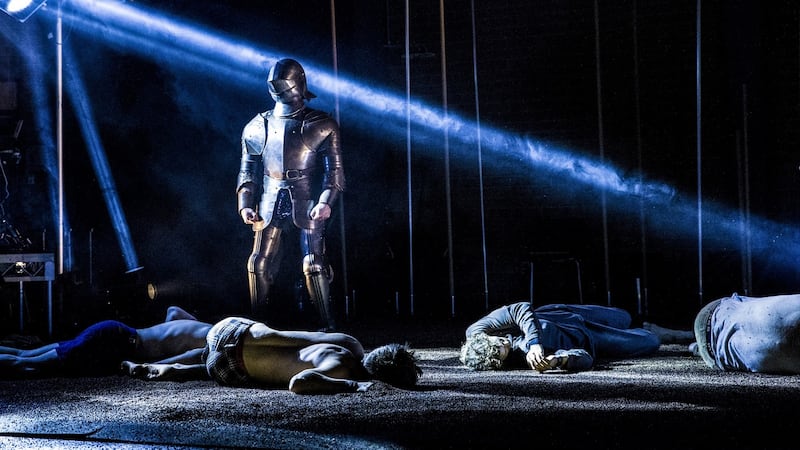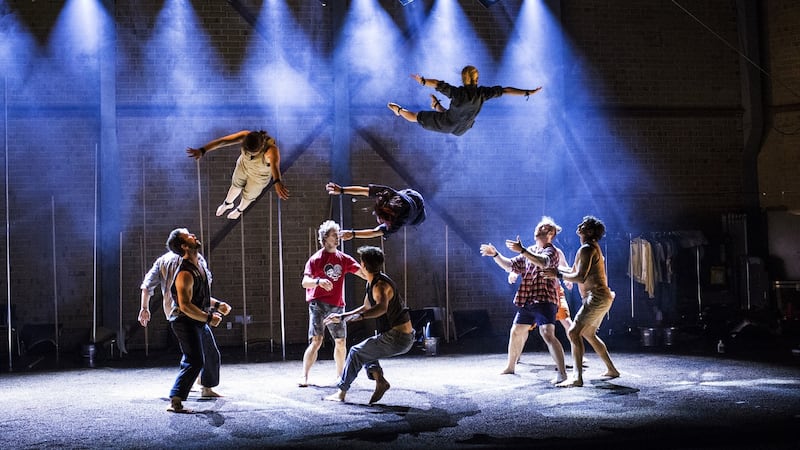In a former slaughterhouse in the north of Prague, there is a bit of grunting going on. After admiring the beauty and skill of what’s happening, the first thing that strikes is: this is risky business. Later we come to understand more about the managed edges of danger in this stretching of the capabilities of human bodies.
The lights are trained on 10 or so strong, able women and men who are doing a warm-up for tonight's opening of Backbone in Prague, and some tricks for Czech TV, with a powerful soundtrack from two musicians. It looks not so much a warm-up as a muscular, telepathically co-ordinated creation of a series of jaw-dropping moving tableaux.
This is the Australian troupe Gravity & Other Myths in action, a company of acrobatic creativity on an extended tour of Europe – and at the upcoming Galway International Arts Festival – with its vigorous circus ensemble.
We're in Jatka78, home of Cirk La Putyka, an acclaimed circus company in the Czech Republic, who four years ago created this airy, high-ceilinged performance space and lounge with an appealing and atmospheric distressed aesthetic. Its 100-year history as a slaughterhouse was transformed, with a lot of work and support, into this creative hub (an inspiration for what can happen when a city makes space available to artists). Their 4,000sq m in the market in Holešovice now hosts international performances as well as Cirk La Putyka's own shows, and we're watching 12 Aussies who have been making a name for themselves in "ground-based" new circus acrobatics, where everything they do in the show is bolstered from the ground (as opposed to supporting the weight from on high). No trapeze or high-wire here; this is person-based, with lots of props.

The name Gravity & Other Myths is not for nothing: the performers reach for the sky as they tumble, fly and somersault. The show plays with the notion of backbone or strength, throwing around ideas of what that is in a series of vigorous vignettes that joyfully – and with visual beauty – push the limits of human capability, and the interconnectedness of the ensemble.
The warm-up involves actual exercises, but also the practice of throwing – literally – one person to another, like a game of vigorous catch with a body as ball. There is a lot of grunting, effort and care. When the lights come up on the show that night, there’s all this skill but with added theatricality. So in performance there are set-pieces using large stones and packing boxes and costume rails and gravel and buckets (and acrobatics with those buckets on heads – so they’re doing tricks blind). It is strong, confident and pacy, with contrasting quieter moments. All this is not done effortlessly – you see the work, you hear the cues, grunts and words between the players, you see the sweat. They do not have magical power and are not made of rubber.
Jacob Randell, a Gravity & Other Myths founder-director and one of the acrobats, chats for a bit, then flies off to warm-up, and we arrange to talk again after the show.
The troupe is touring two shows in rep through to the middle of next year: Backbone (usually 10 acrobats and two musicians – but there can be a bit of juggling with roles if one is away or recovering from injury) and A Simple Space (seven acrobats and a musician), in Europe – from Norway to Belgium to Latvia – with some Canadian and US dates too.
Five of the original seven founders still perform with the troupe (one of the founders is now an actor and the other has a physio and yoga business). It was founded in 2009 by a bunch of pals who had been to CirKidz school in Adelaide together, with others joining them along the way.
There is, it seems, a youth circus culture in Australia, which another founder-director Elliott Zoerner describes as attracting "people who want to be active and creative, rather than joining a sports club, which is more competitive, or joining a drama school, which is just the creative side".

Australia’s new circus folk gather and learn and network at big circus festivals in Tasmania and in western Australia, with performances and workshops. Circa, from Brisbane, paved the way for Australian contemporary circus; as did Casus, also big on the same international scene.
Grace and beauty
Gravity & Other Myths' ground-up contemporary circus style melds the skill and strength of their tricks with grace and beauty, often with a humorous touch. Backbone takes the form of a series of elaborate, vigorous games between friends, and is about strength. But it also points up the precariousness and vulnerability of humans, and how strong bonds and interdependency can create strength.
The pals from circus school made their first show, Freefall, when they were 18 and 19. While some had planned a circus career, for others it was more accidental – three of them "interrupted" engineering at university when they started to take off internationally. That happened when they took A Simple Space to the Edinburgh Fringe in 2013, and it was picked up by an agent, who has since scheduled their busy tours. That agent is Aurora Nova, the Berlin company set up by dancer and theatre maker – and one-time Dublin Fringe Festival director – Wolfgang Hoffmann.
One of those would-be engineers was Martin Schreiber, a "four-high base"; he's the biggest and strongest-looking of a pretty strong lot, and that job title means he specialises as the bottom of a human tower of four people performing while standing on each other's shoulders.
Zoerner, another almost-engineer, joined his pals’ troupe and ran away with the circus, as resident composer and musician. He plays drums and percussion, writes electronic music for the show and does sound design. He plays with Shenzo Gregorio on keyboards, viola and looping station (and sometime acrobatic understudy).

Gravity & Other Myths have toured almost continually since that Edinburgh break, and they enjoy the new circus lifestyle, says Zoerner. “I’ve spent a year travelling while working and getting paid for it. It’s a great way to travel. You have a different experience to being a tourist. You live on the road, see interesting places along the way and meet people in a more genuine way – theatre techies and people who come to your show.”
It’s a big group on the road now, with 12 performers, a few partners and a lighting and technical person, while their general manager operates from Adelaide.
Trust is essential
Discipline and training are crucial, but trust is clearly central in this. As we watch the warm-up together, Zoerner says they have to be able to second-guess each other for it to work.
“If someone is going to do something and you don’t trust them, the tricks are going to fail. For example, when a flyer is about to get caught by somebody, if they have an engaged body – keeping their muscles tight and staying still in the air – it makes them easier to catch. It’s more like catching a solid object: it’s predictable and easier for the bases to catch. Whereas if they’re moving around and panicking, it makes it really hard because the bases can’t see where they’re going to go. The smartest thing for flyers to do, even if they think they are going to fall, is to be still in the air and to get into a good position to be caught.”
This all sounds terrifying. Elliott laughs and agrees: “It’s a bit scary. It’s hard to do. That’s why they’re so good.”
But it is risky. There are no nets or harnesses. Most injuries, says Zoerner, don’t come from acute things but from using muscles over time, and the general stress of doing an acrobatic show daily. Although as we chat a colleague is at the hotel (“it’s tough to watch a show you want to be part of”) recovering from a back injury a couple of weeks ago, “we don’t get many injuries. This is the first time someone has been out of this show in a year and a half.”

They use safety lines to practise the biggest tricks each day, especially the four-high. The process for this involves putting the top person in a harness, and having them in lines. Once that’s comfortable you take them out of the lines and do it without. The routine is daily, to keep skills up but also to keep the players comfortable.
“Obviously there is a lot of trust. If a trick isn’t feeling comfortable, it’s bad for the trick. It’s a vicious cycle. So having the lines there when practising is somewhat to test the waters to see everyone is good to do it, and also to get to the stage [where] ‘That felt easy, we didn’t need the help of the lines. We’ll do it again without.’ ”
It’s “not as risky as a lot of sport, because in sport what’s going to happen is so unpredictable. But in this, or any circus show, the idea is you know what’s going to happen. There are some improvised bits, but they know to be very careful with each other. Where it is planned, they know what’s happening, and for the dangerous tricks they have people underneath supporting them to make sure that if something does go wrong there are plenty of people there to catch somebody.”
Focused performance
Later that night, watching Backbone, you realise this is unobtrusively happening all the time: while a performer is on high, their colleagues are attentively looking up, watchful, careful. Aside from the beauty and humour and skill, this is a very focused performance.
And then, almost imperceptibly, something has happened. As if part of the performance, some players gravitate towards Jacob Randell, some touching his arm in concern. You realise he has been hurt, but it seemed part of the flow of the show. Then, another slight movement by the players, and you realise Randell is no longer onstage. The remainder of the show closes seamlessly over his presence, and one trick is skipped. He doesn’t appear for the (enthusiastic) curtain call.
Later we learn it was a bone injury (“there was a bit of a dent in my shoulder from the sublux”). A couple of weeks later his shoulder is slowly getting there but he is still not performing – “Getting on the rehab hard now, so hopefully not too much longer”.
Rendell is looking forward to Galway, though he’s not sure if he’ll be performing by then. It’s a reminder of how, even with great skill and care, sailing close to the wind is still pushing the boundaries.
- Backbone is at the Galway International Arts Festival, July 17th-21st, Bailey Allen Hall, NUIG. €20-€29. giaf.ie












